

Vista has eliminated the fly-out menus that appeared when you clicked on "All Programs" and added the quick search (see above where it is used to find the "Welcome Center") so this is not as critical as it was. The problem is that when we're looking for something we infrequently use, we don't know its name either so search doesn't really help us. Therefore, I still like to keep "All Programs" organized into a few major categories (top level folders): one named for the Computer Manufacturer (which contains all the programs, manuals, etc. supplied by the computer manufacturer, Acer in this case), one named Microsoft (all programs supplied by Microsoft), Tools (all the other "tools" you need on your computer), Accessories (another Microsoft created folder which has lots of stuff I leave where it is), Games, and Graphics (because if you're looking at this website you probably install lots of graphic programs ... this is a good place to put them). If you keep things organized in a few categories that make sense to you, it's much easier to find a program which you only have a very occasional need to use.
When you click on "All Programs" in Vista you see something like this (you can see by the scroll bar, I've already scrolled down):
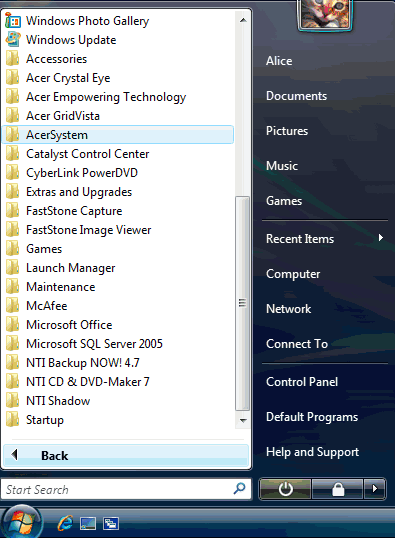
It may "look simpler" without the fly-out menus which show you ALL the programs installed, but if you don't keep it organized, or use the search function it's actually harder to find infrequently used programs. To organize your "All Programs" menu, right-click on "All Programs" and choose "Explore All Users":
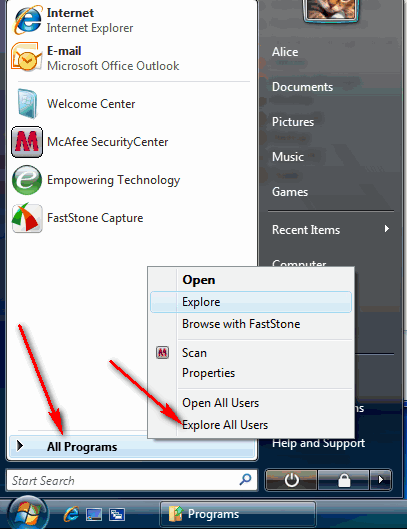
I forgot to capture the next screen, but this opens an Explorer window to the "Start Menu" folder for all users. In Vista this is located under ProgramData / Microsoft / Windows; in XP it was under Documents and Settings / All Users. The area highlighted below in green gives you a sense of the folder structure. There's a folder called Programs and in this folder software manufacturers create folders for each of the various products you install (you see a couple of ones for FastStone, one for McAfee, etc.) This is where you want to create the folders I was talking about above. If there's not already a Microsoft folder I'll usually rename some folder with Microsoft programs; here I'm renaming a folder called "Maintenance", changing the name to "Microsoft":
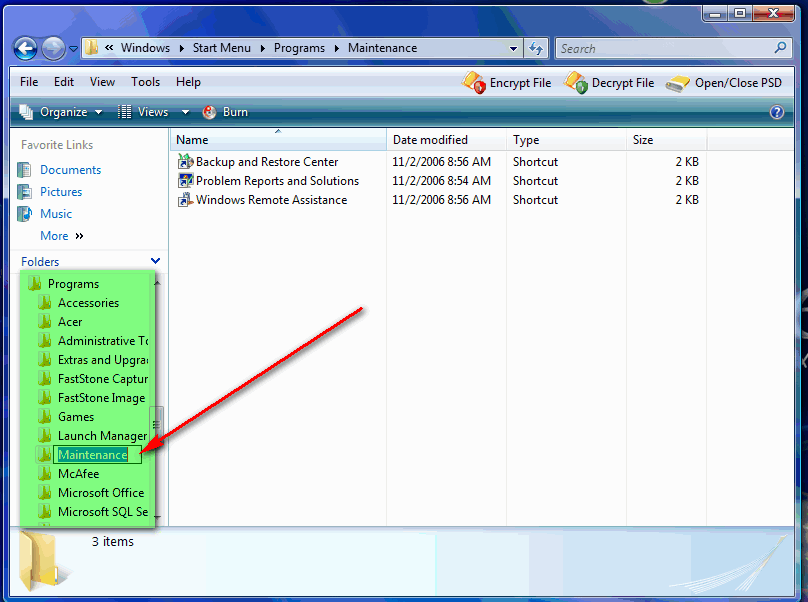
After I had created the Microsoft folder, I would drag other folders with Microsoft programs and drop them into this folder. Some of those are highlighted below in green:
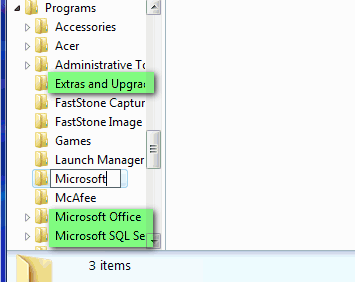
Next I created a "Tools" folder by right-clicking on the "Programs" and choosing New / Folder:

And while the words "New Folder" were still highlighted typing the new name "Tools". Some of the folders I might put in here are the ones highlighted in green ... they seem to be the programs that Acer has installed for creating CDs and DVDs on this machine.
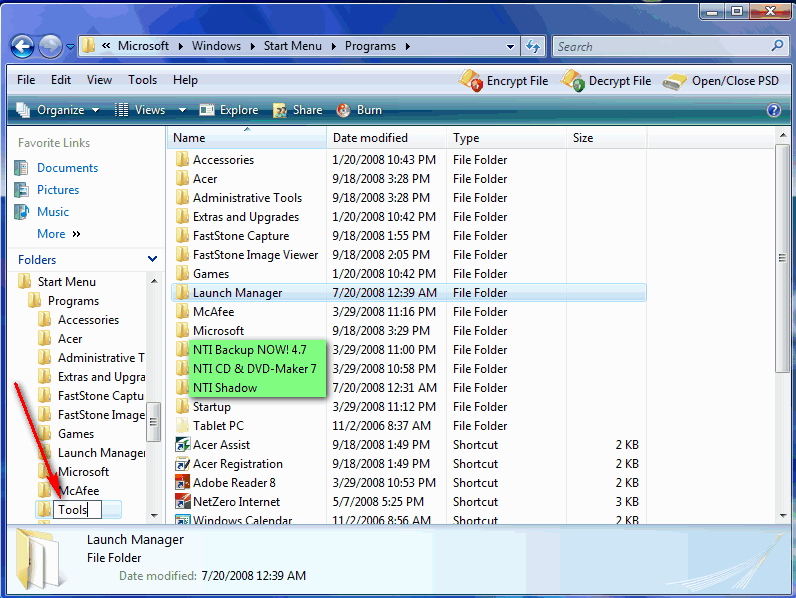
Above you see that the folder icon for the "Tablet PC" folder is dim ... that indicates a hidden folder ... I'm careful to leave them alone. Below that we see some short-cuts, I'd drag the Acer ones into the Acer folder, the Adobe Reader one into the Tools folder, probably throw away the NetZero Internet one or hide in a special "Other Stuff" folder I create under the Tools folder (often you'll find a lot of "special offers" on the desktop ... I put them all in "Other Stuff" ... that gets them out of the way, but you still have them in case you want them later. At the very bottom you see the first of many "windows programs" short-cuts, I put them all in the Microsoft folder. Anyway, you get the idea ... organize things in a way that makes sense to you. (Leave the "Startup" folder ... this is where programs the you want to run when your system starts go.)
Once I've got the folders and short-cuts for "all users" organized under a relatively few top-level folders, next I open the start menu for the individual user by again right-clicking on "All Folders", but this time choosing "Explore":
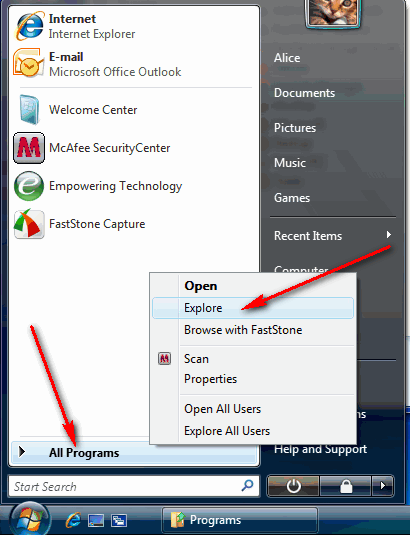
Windows merges together everything found in this tree structure with that found in the "All Users" we just organized. The concept makes a lot of sense if you're going to have several people use the same machine, each with programs only they use. But you're probably the only person using your machine (and if you do want to add another user later you probably want them to get to all the programs you have anyway). Therefore, I like to move almost all the stuff from this tree to the "All Users" tree. As you see below, I do this by keeping "All Users" open in one Window, here it's open to the Microsoft folder (red arrow), and dragging short-cuts from one window to the other. Here I've highlighted three shortcuts (blue arrow) that I'm dragging and dropping into the All Users "Microsoft" folder. A nice little feature of Vista is that if you pause for a second, it will show you exactly what it's going to do, in this case MOVE 3 short-cuts to the "Microsoft" folder (green arrows):
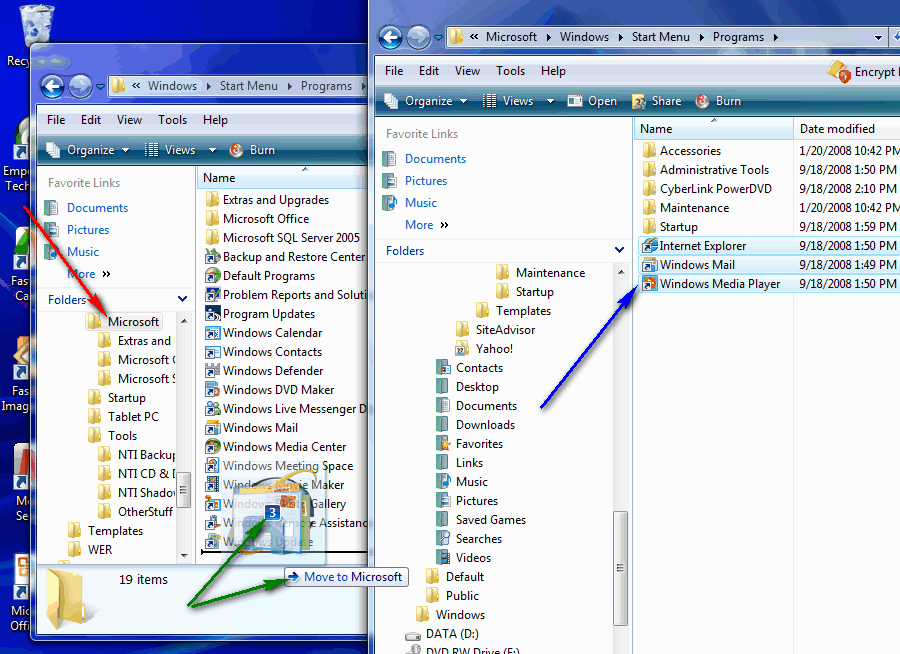
I'm doing the same thing below, I clicked on the "Help and " short-cut, held down the mouse button and dragged it over into the Microsoft folder under All Users. Note that I release it between some other short-cuts, not on top of a folder (otherwise it would end up in that folder). You needn't worry about putting it in alphabetical order, the names will later sort automatically:
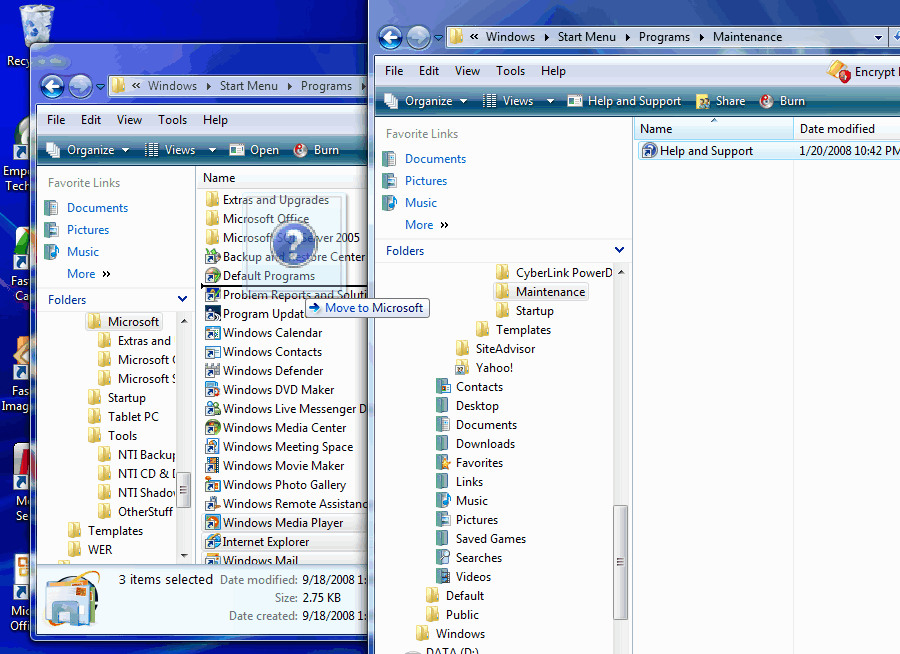
Since the Maintenance folder under "" is empty, I right-click on its name and choose delete:
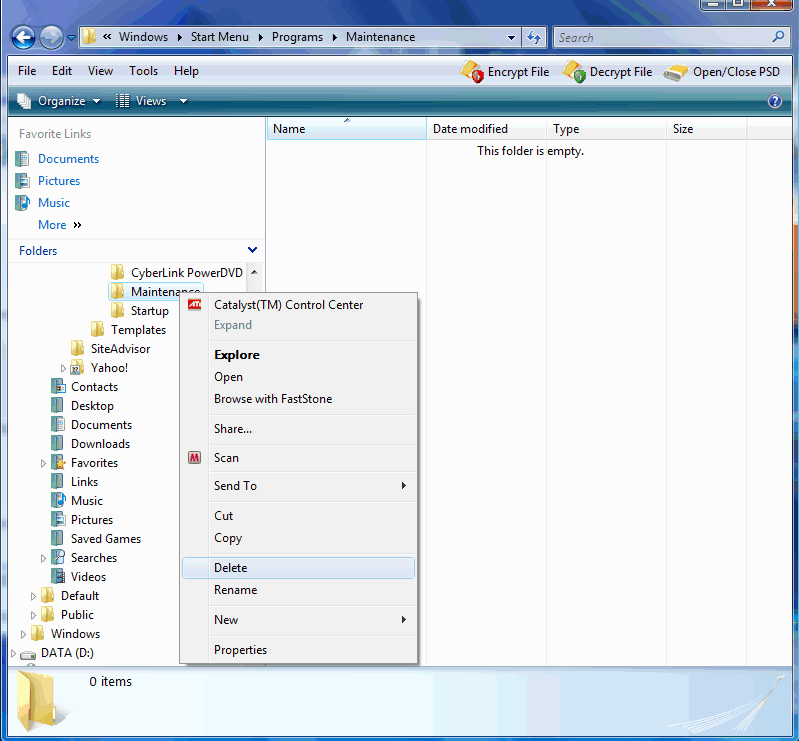
Although you can't see the entire path above, in Vista the Start Menu folder for an individual user is found under: Users / AppData / Roaming / Microsoft / Windows / Start Menu. "AppData" is a hidden folder, so you normally wouldn't find it ... another reason I had earlier changed the Folder Options to allow Explorer to show hidden files and folders. Just remember, that whenever you see an icon that is dimmer than the other it is hidden and you probably shouldn't mess with that file or folder; but it's usually OK to modify files under a hidden folder. Below I'm looking at the contents of a folder named "", since it looks like more programs for creating DVDs I'll click on the folder name (I can click on folder names in the left-hand folder column as well) and drag it over to the "Tools" folder (also in the left-hand column of the other (All Users) windows). Again as I pause, Windows tells me exactly what it's going to do (Move, Copy, etc.) ... also note that as I pause over the Tools folder Windows will also expand the Tools folder and display the names of folders under it (the NTI and OtherStuff folder we had previously put there) ... just be careful as this happens things might move around a bit, be sure you're still over the folder you want it to go in when you release the mouse button:
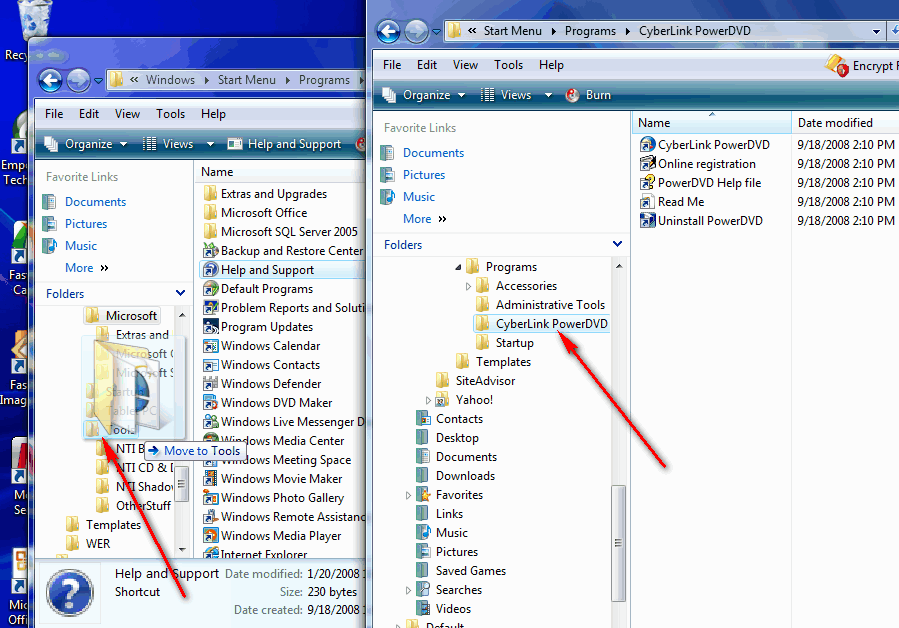
I keep doing the same thing with other folders, here I've selected 4 short-cuts in the individual user's Accessories folder and am moving them to the Accessories under All Users:
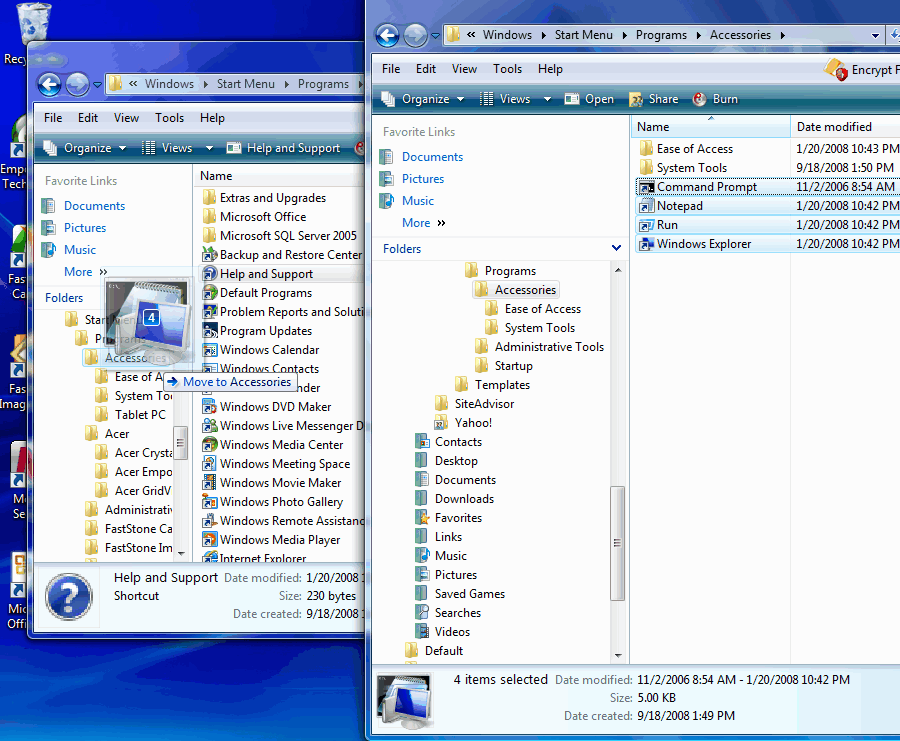
And here short-cuts in the individual user's Accessories/System Tools folder and moving them to the same folder under "All Users":
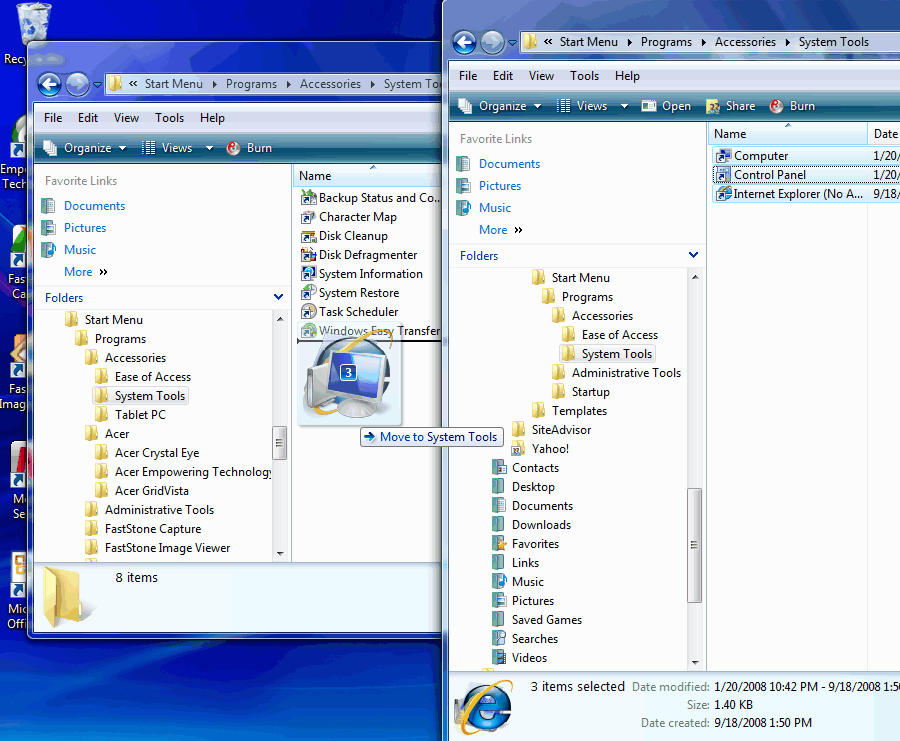
As I said, the only reason I'm doing this to make my life easier later ... all the short-cuts will be in one place and available to any user I create later. Don't worry about putting something you don't recognize in the wrong place, if in the future you figure out what it is, it's easy to move. For example, about 7 or 8 screen shots up, there was a "Launch Manager" that I'd never seen before. Sometime later I figured out it controlled some extra buttons above the Acer keyboard, so I moved it to the Acer folder.
Suggested next choices: